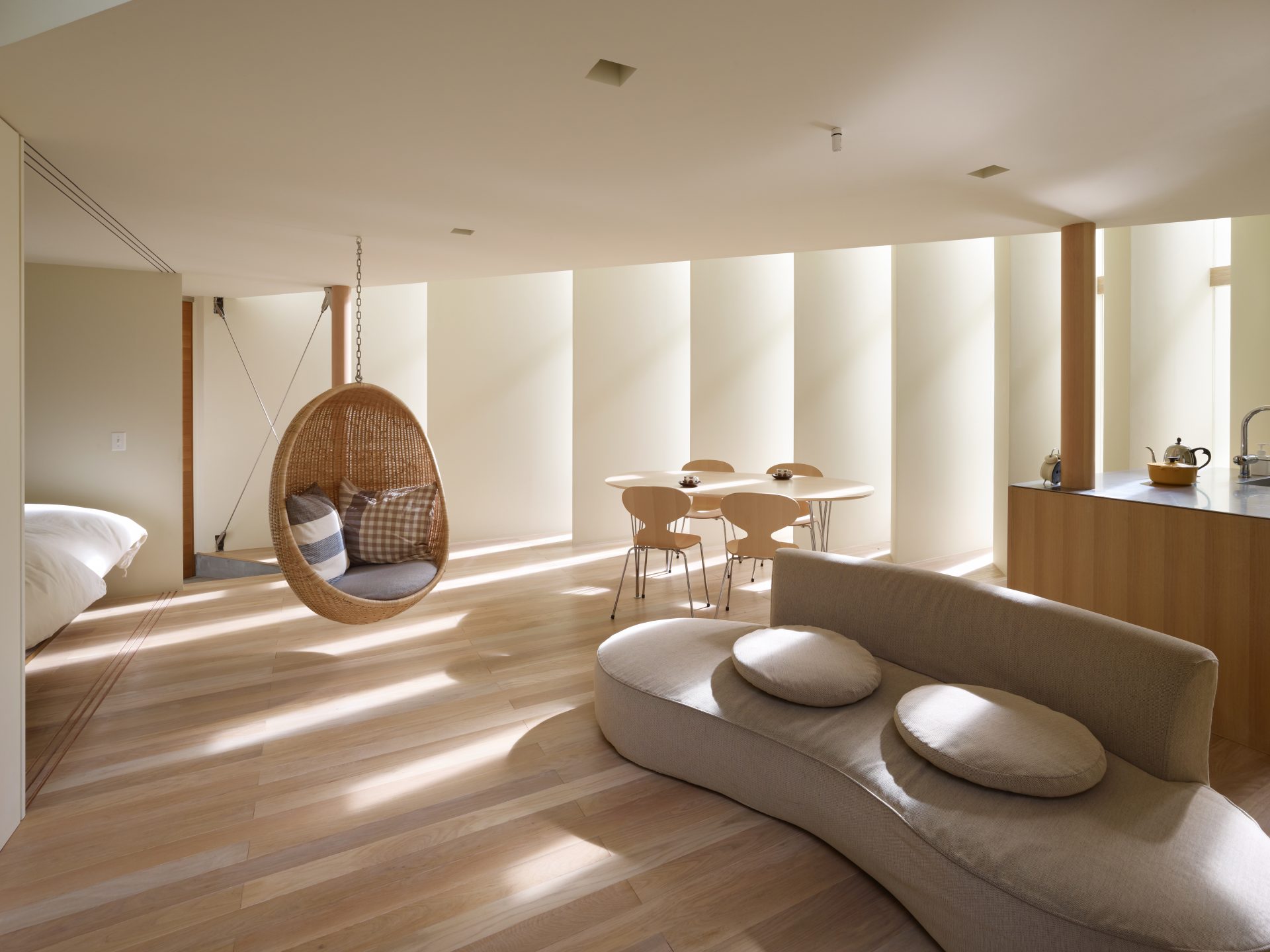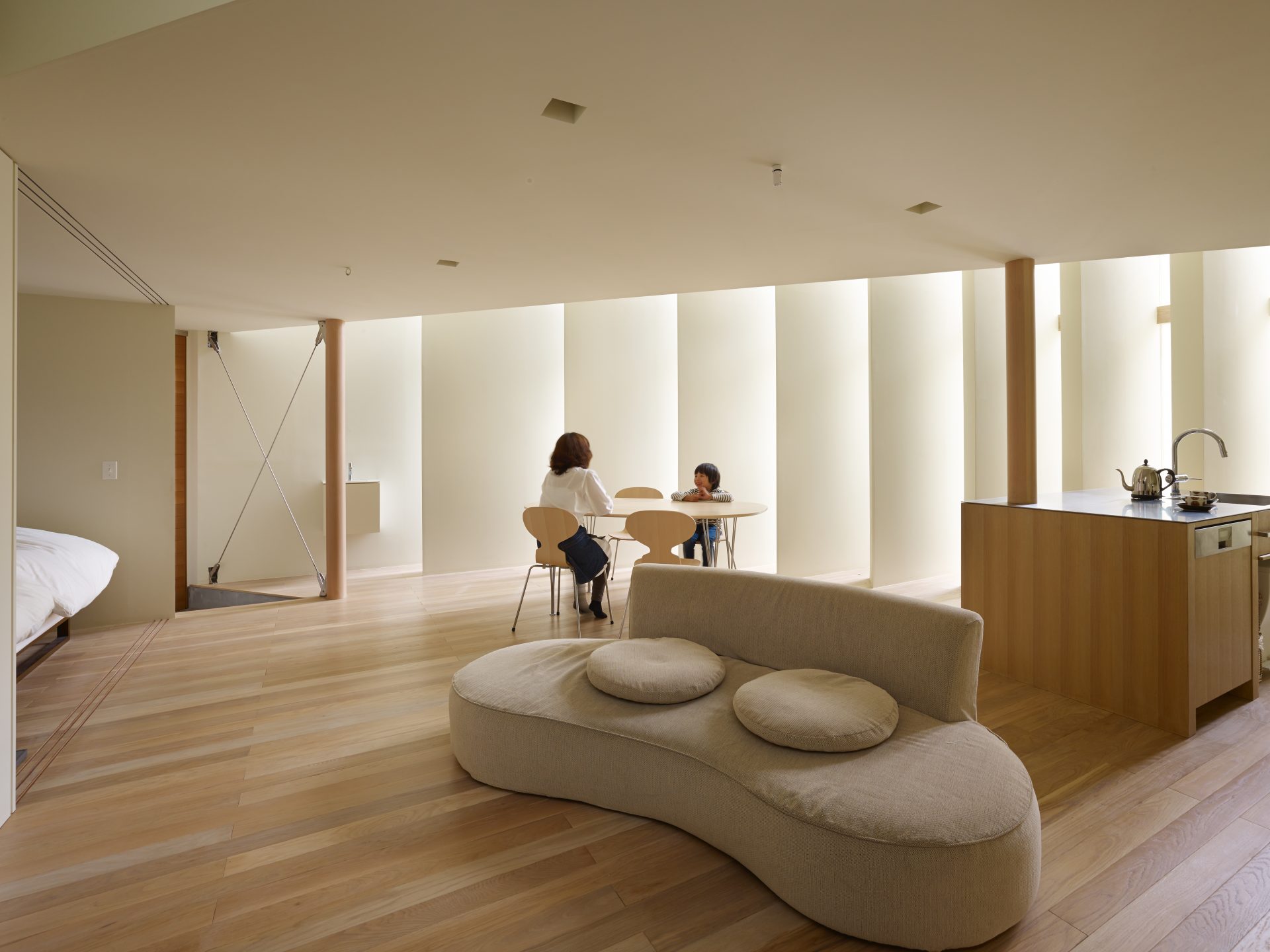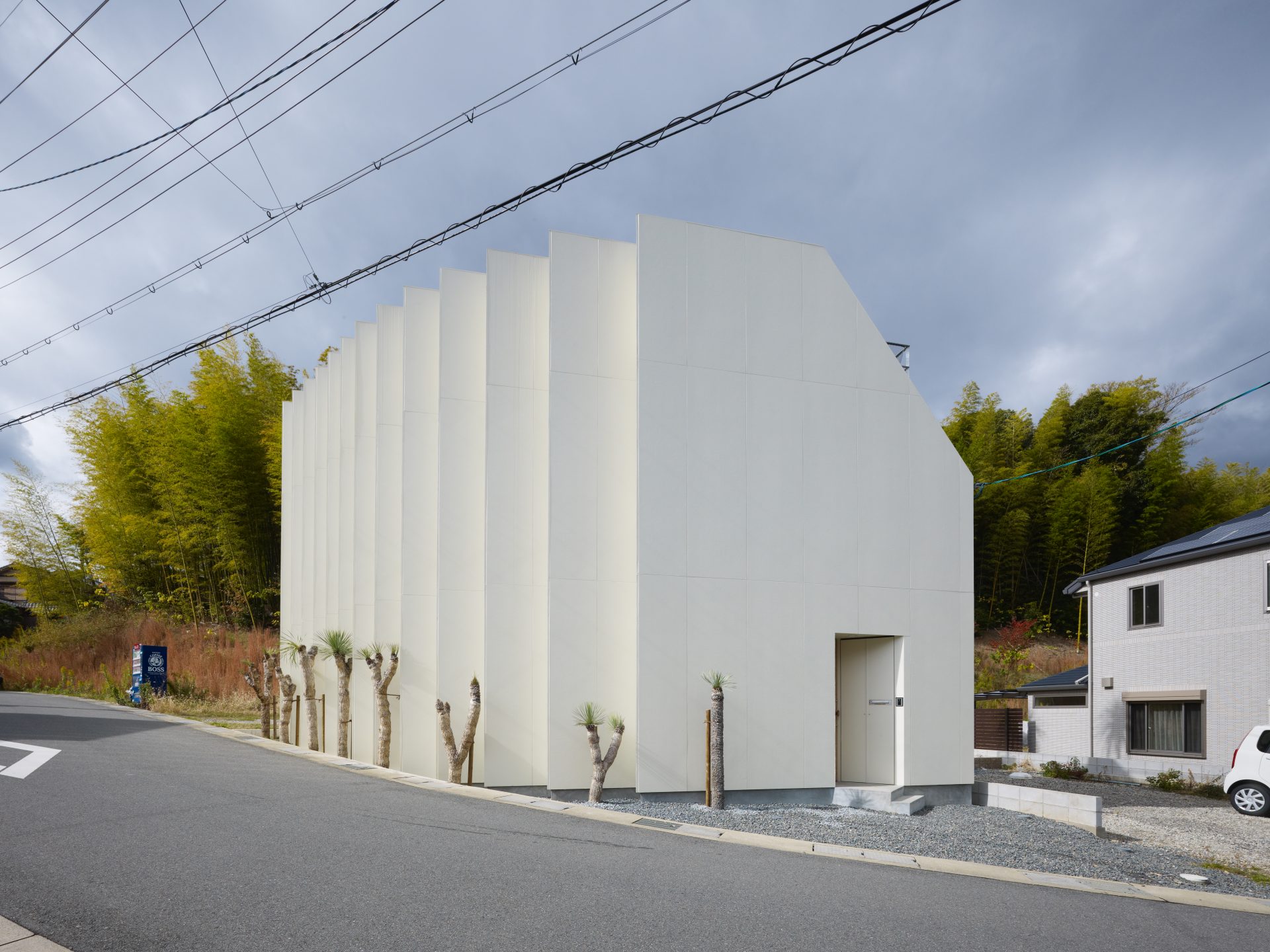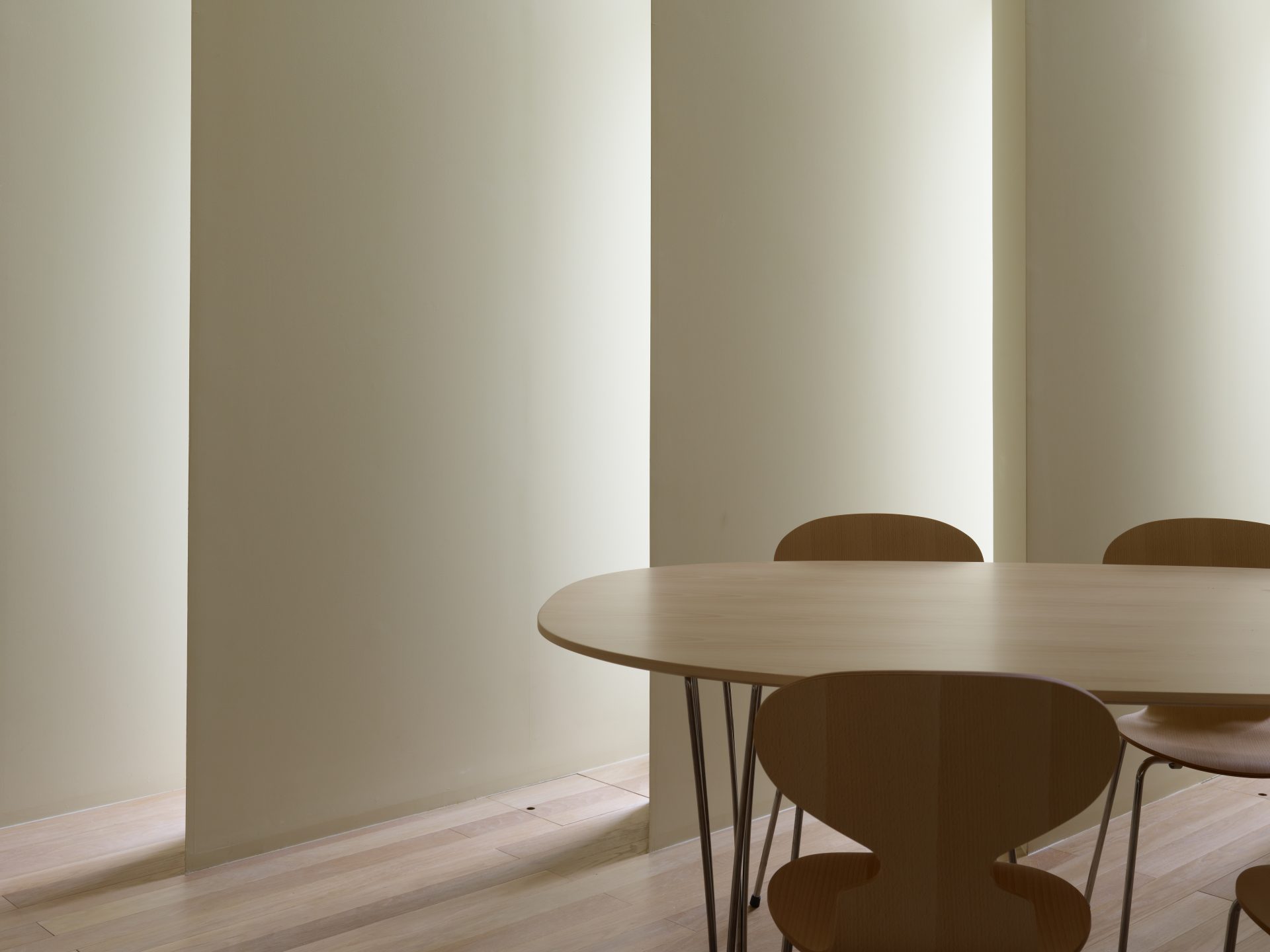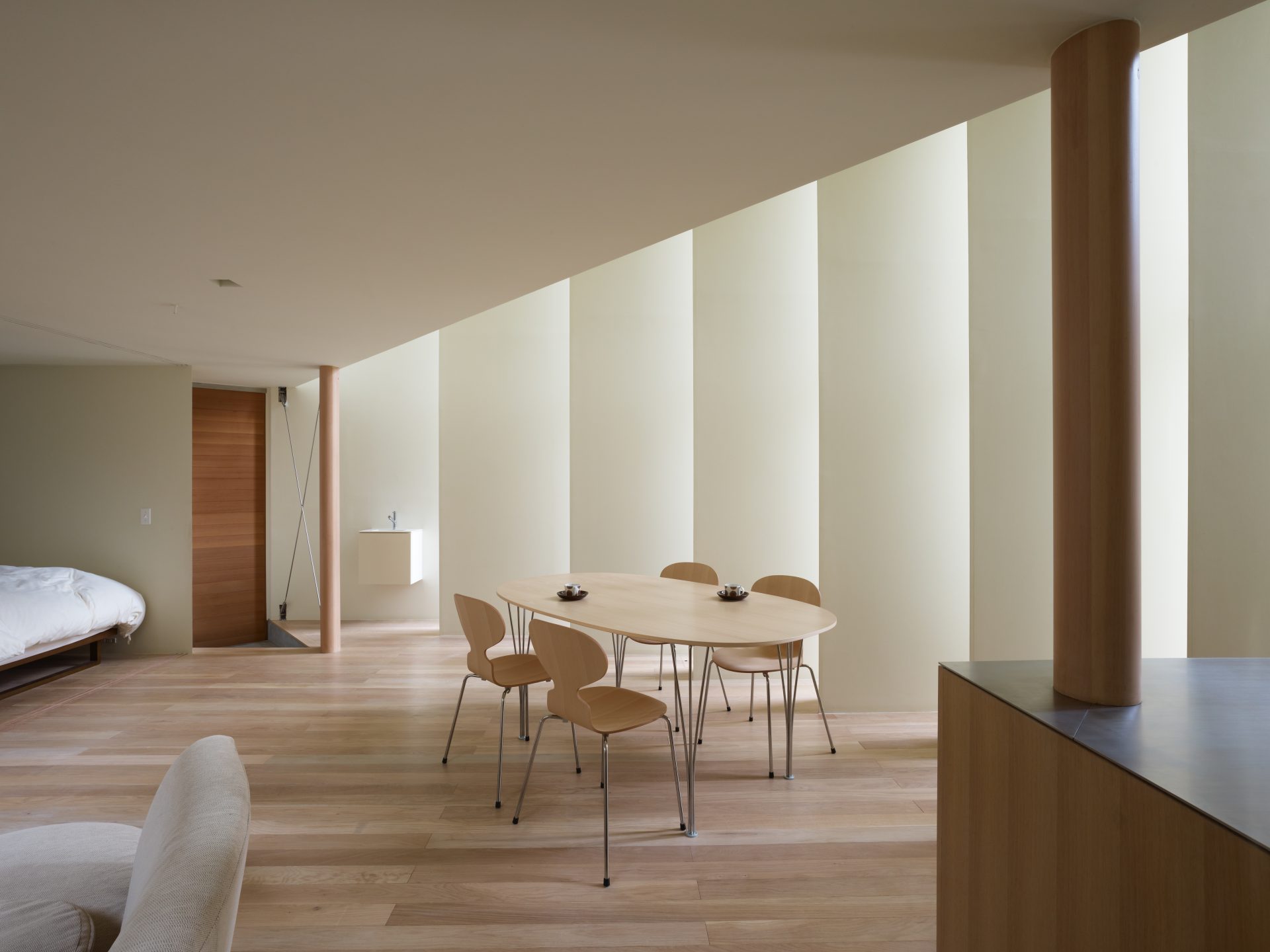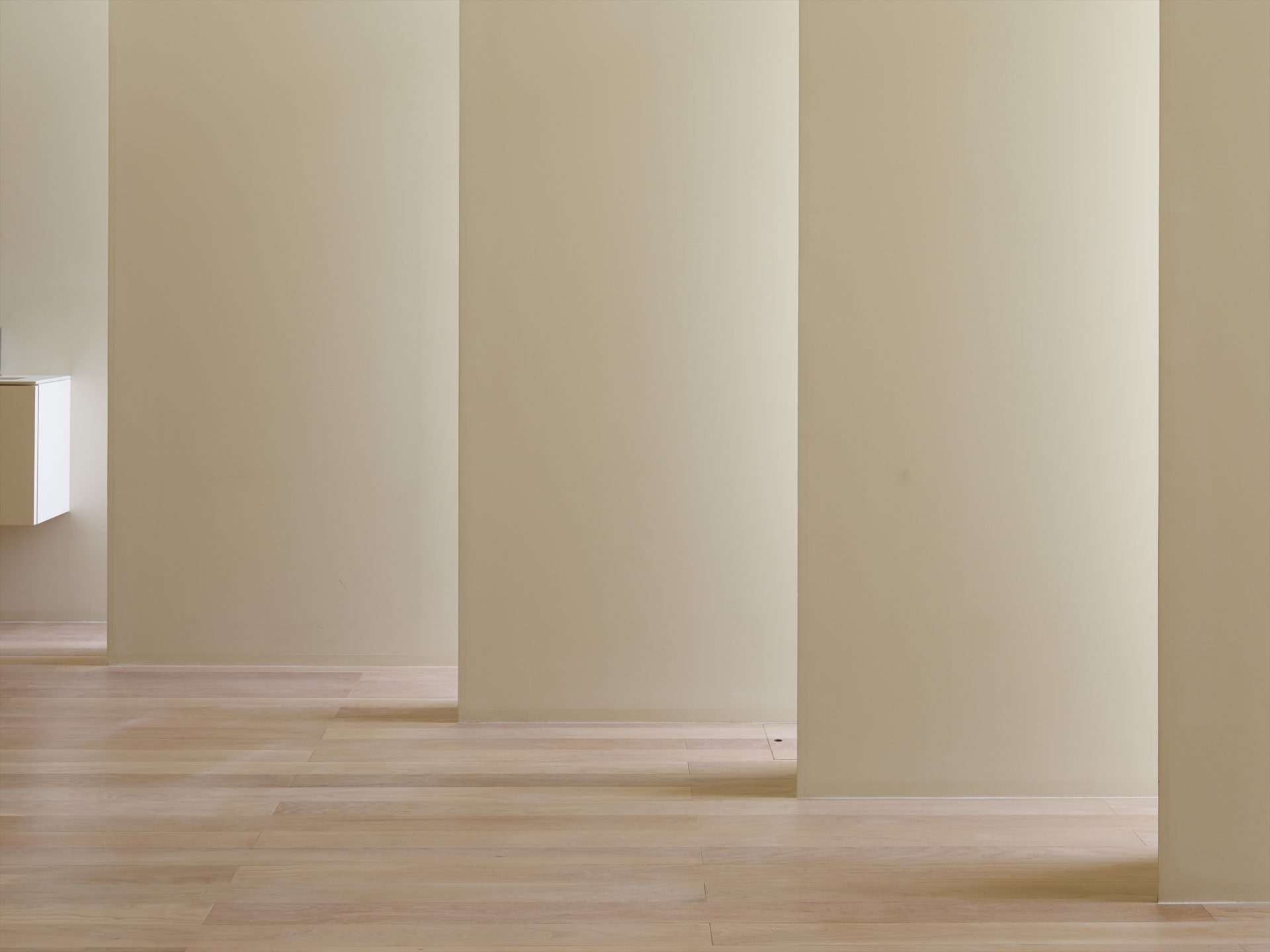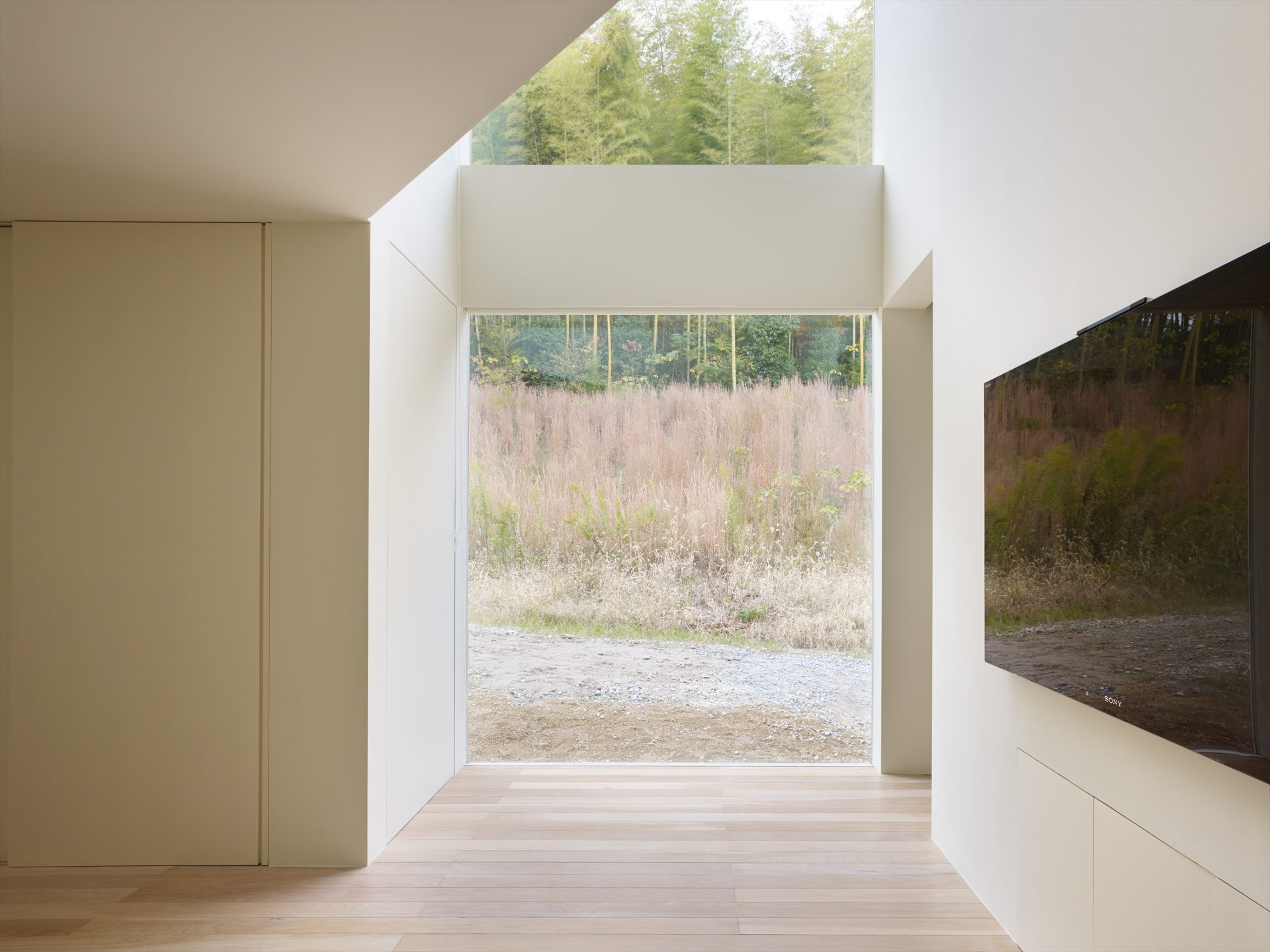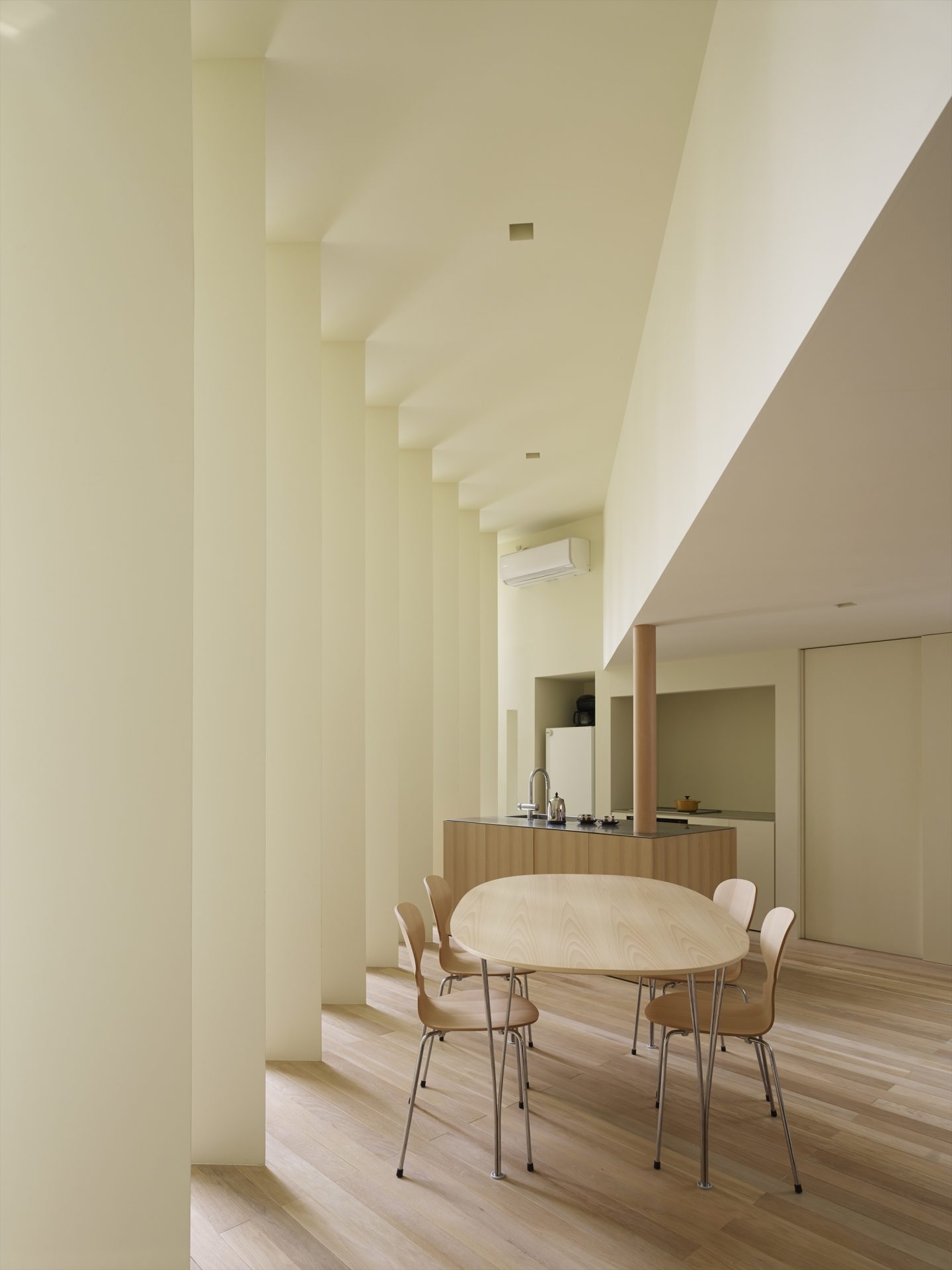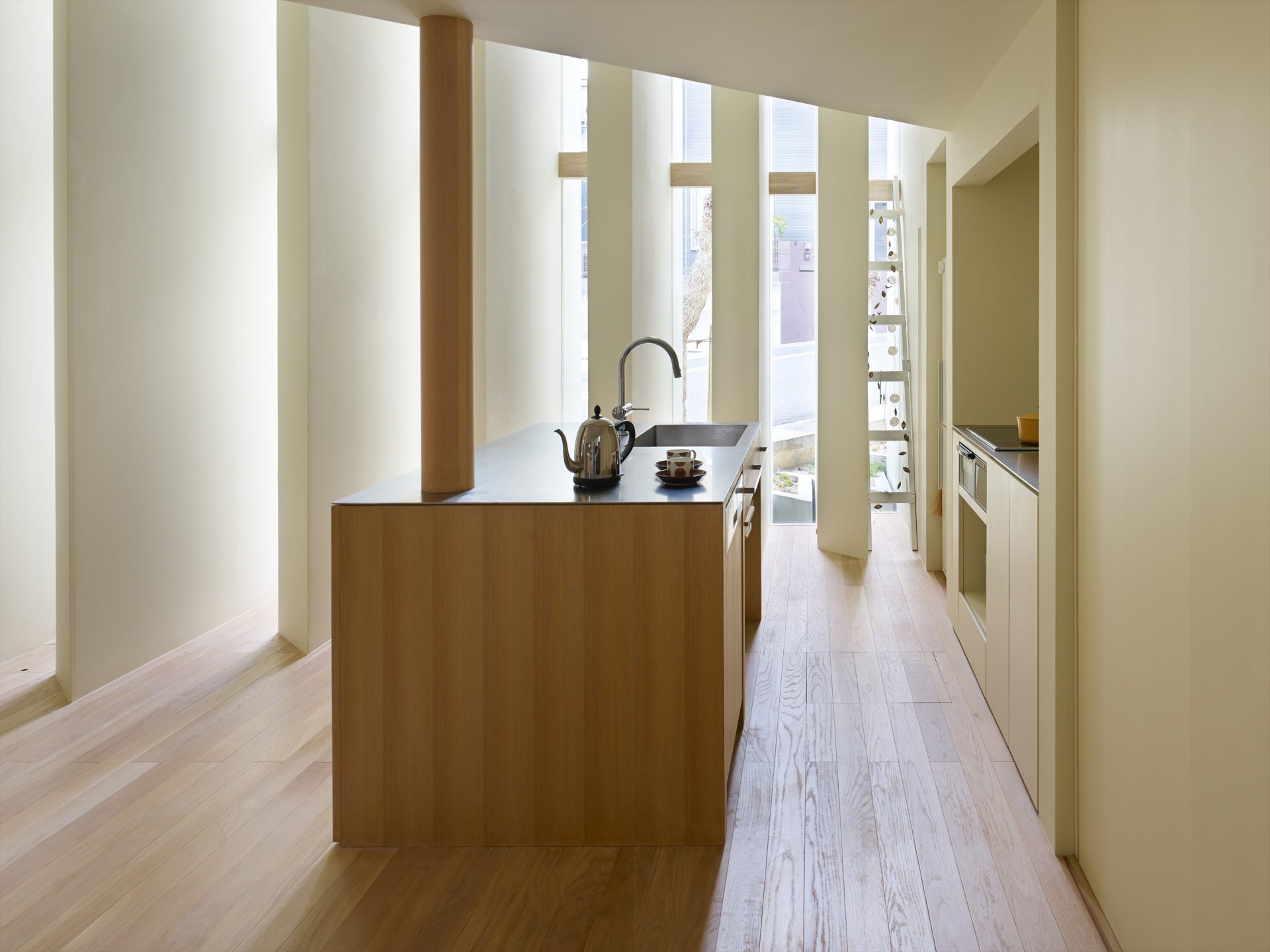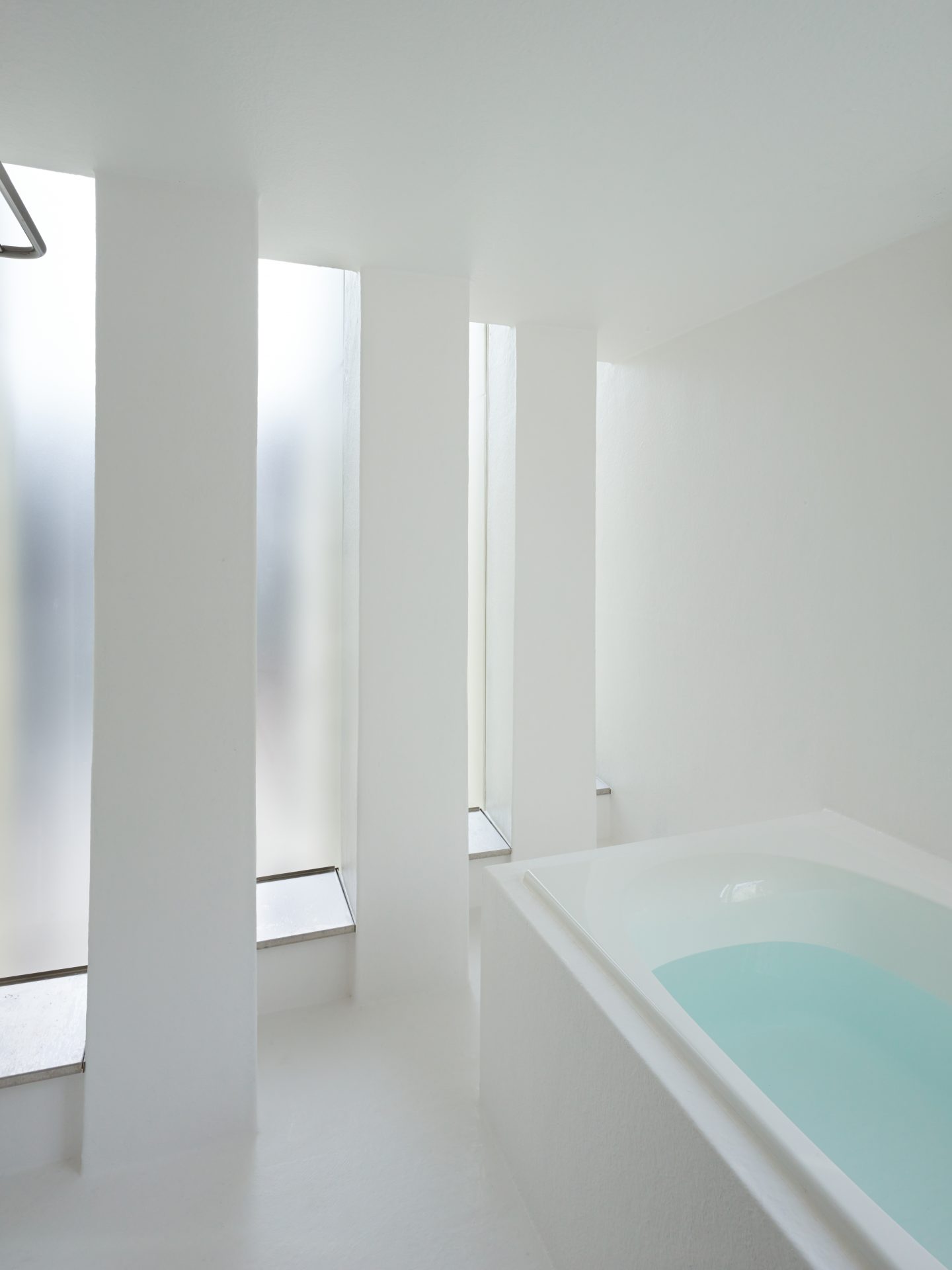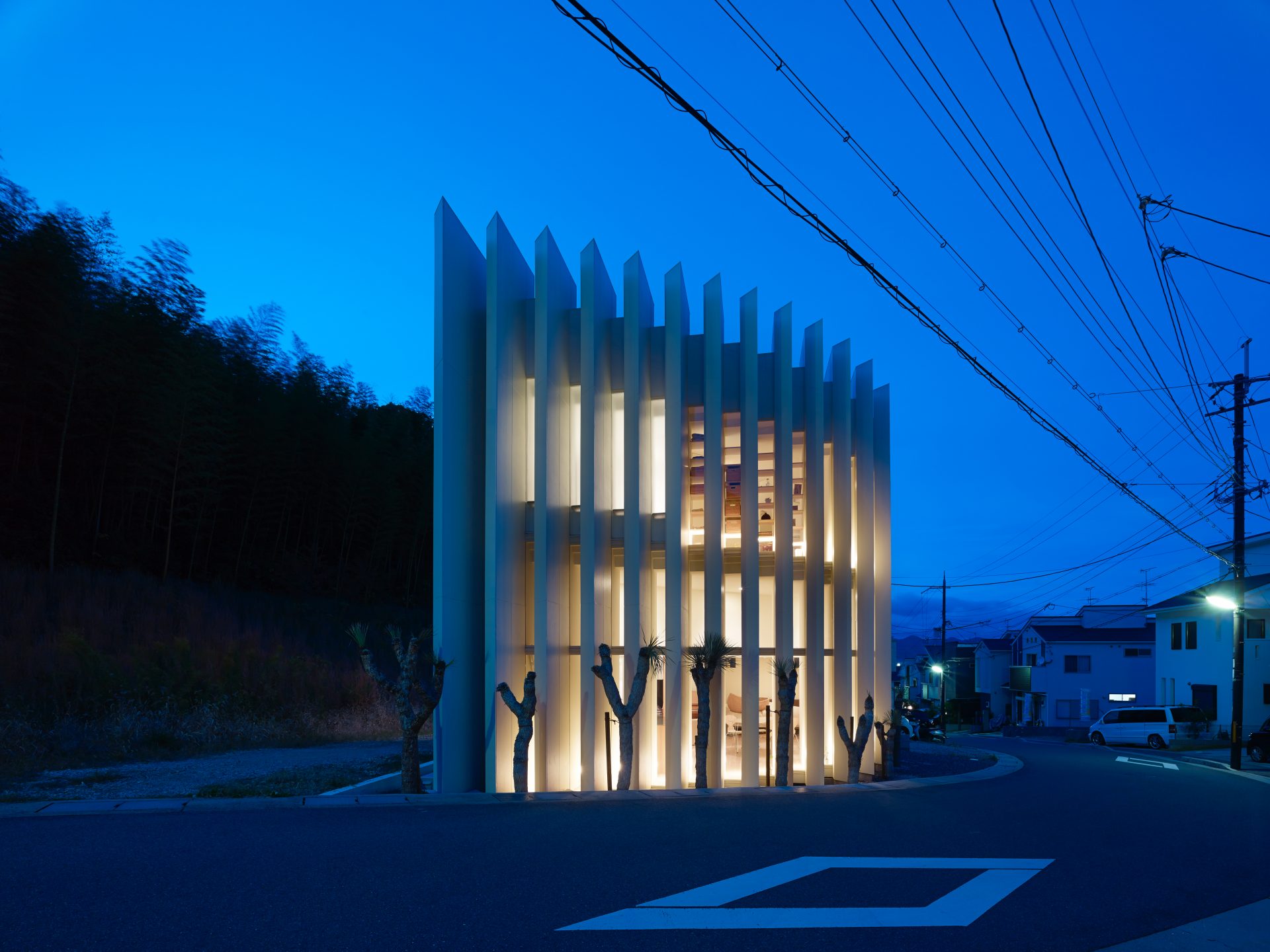向日の家 Houuse in Muko
建築主は、面白い家を建てたいということで、あえて扇形の敷地形状を購入したとのことでした。 住宅街の端に位置する敷地で、西には竹林、南面、東面ともに道路に面した敷地となっています。
建築主の要望は、明るい環境のなかで、家族の気配を感じつつ、一室的な空間の中で家族が住む家づくりを、希望されました。
そこで、3面が開放された敷地で、道路という条件と敷地形状を利用して、光を建物の中に導くことができないかと考えました。そこで、道路側のファサードには、大きなルーバーを設けました。奥行きのあるルーバーとすることで、道路を通過する人や車からは目線をある程度さえぎりつつも(基本的にはプライバシーはあまり気にならないとのこと)、光を家の中に導きいれる住宅設計を提案しました。ルーバーを道路に沿って段階的にずらすことで、時間の経過にあわせて、室内の表情の変化が楽しめます。
| 用途 | 専用住宅 |
|---|---|
| 家族構成 | 夫婦+子供2人 |
| 場所 | 京都府向日市 |
| 敷地面積 | 100.1m²(30.28坪) |
| 建築面積 | 56.3m²(17.03坪) |
| 延床面積 | 100.1m²(30.28坪) |
| 構造 | 木造 |
| 階数 | 地上2階 |
| 竣工年 | 2012年 |
| 写真撮影 | 矢野紀行(矢野紀行写真事務所) |
出版/受賞
- 2025年 04月
- 日本の設計事務所4位にランクされました
- 2021年 02月
- 居心地のいい家をつくる注目の設計士&建築家100人の仕事
- 2018年 09月
- Void(SendPoints Publishing Co., Ltd.)
- 2017年 06月
- フジテレビみんなのニュース 向日の家
- 2016年 01月
- JUTAKU(PAHIDON) ―イギリスの建築図書
- 2016年 01月
- 24th World Architecture Community Awardsにて名誉会員賞および一般会員賞
- 2015年 10月
- 住まいの設計2015年11,12月号55の家55の暮らし
- 2015年 07月
- Japanese Contemporary House (イタリアの建築図書)
- 2015年 05月
- JIA建築年鑑2015 公益社団法人日本建築家協会
- 2015年 05月
- The Japanese House Reinvented (Thames & Hudson イギリスの出版社)
- 2015年 01月
- 日本建築家協会優秀建築選100選
- 2014年 12月
- 「Extreme Homes」アメリカのTV番組
- 2014年 09月
- ai architecture of israel イスラエルの建築雑誌
- 2013年 11月
- テレビ朝日 「仰天ハウス探偵団」
- 2013年 07月
- 日本テレビ「スッキリ」 扇形の土地に建つギザギザハウス
- 2013年 07月
- architecture ASIA Issue1-2013(ARCASIA) architecture ASIA Issue1-2013(ARCASIA)
- 2013年 04月
- DIVISAREに掲載されました
- 2013年 03月
- Archidailyに掲載されました
- 2013年 03月
- desighboomに掲載されました
- 2013年 03月
- Dezeenに掲載されました
- 2013年 03月
- MARK♯42(オランダの建築専門誌)
The house is located in a neighborhood some distance to the south-west of an area in Kyoto known for its historical buildings. Despite its being in Kyoto, however, this particular neighborhood is a newly developed residential area filled with contemporary buildings and lacks any sense of the traditional cityscape. The plot of land on which the house is built is shaped like a fan with roads bordering the southern and eastern sides and a bamboo thicket on the west side. It sits near the top of a hill that slopes upward from east to west. The owner purchased this land because of its unusual shape, anticipating the building of an interesting structure. In addition to his desire to capitalize on the shape of the land, the client also requested the inside of the building to be one continuous space with no partitions between the rooms. Our conception of the design was based on these two factors.
One feature of the site is that there are no buildings adjacent to it other than on the north side. It is situated so as to receive a lot of sun light, especially on the eastern and southern sides. Due to this exposure, we decided to make the element of light the central axis of our design. We made it our aim to create a residence in which one could experience the movement of the sun from within the house.
We set gigantic louvers in place on the south side of the building, 8 meters tall and numbering thirteen in total. The use of louvers allows for light to reach far back into the house and they also serve as blinds, blocking the line of vision from the road. The light shining from the south enters in from the east, hits the louvers and is reflected back, scattering into the house. In the morning, the light gradually increases, reaching a climax at midday. At this time, the direct rays of the sun striking from the south form lines across the room like a shower of light. The design has similarities to trellises on the façade of merchant houses in Kyoto and also brings to mind traditional Japanese partitions, paper sliding doors called shoji. The lattices found on the façades of merchant houses make it difficult to see into their interiors from the outside. The use of shoji allow for light to be dispersed far into the house. The gigantic louvers combine these two functions. The sunlight coming in from the west hits the wall of the atrium and is reflected back into the room. A view of the bamboo thicket can also be enjoyed from the windows facing the west on both the first and second floor. Another feature of the exterior are the Mexican "Yucca rostrata" plants, which are planted on the south side.
The inside of the house is a large one-room split-level dwelling space. On the first floor is the kitchen, dining room, living room and bed room. Since the request was for a unified space, we sought to make the structural pillars inconspicuous by incorporating them into the layout of the kitchen. The lower section of the 2nd floor contains the playroom, and the study, the wash room and the bath room can be found on the upper part of the 2nd floor. On top of all of that sits a rooftop deck space.
The playroom on the 2nd floor is an open space that is like an extended landing of the staircase. Its size was configured so that in the future it could be divided into separate rooms for the two boys. The 2nd floor of the house is a skip floor. The north side of the property line is affected by regional regulations which limit the height of the building to 5 meters from the ground. One of the conditions in designing the house was to provide a spot for the wife’s dresser, a marriage gift. However, making room for the bureau on the 2nd floor meant the height of the ceiling on the first floor had to be adjusted accordingly, and the low ceiling ended up giving an oppressive feeling to the space. We decided to raise the level of the ceiling on the south side, which is not under the same regulations, in order to bring in more light. The result was a skip floor. The top floor makes use of the crevices in part of the louvers as storage space. From the bathroom, there is a view of the bamboo thicket. From the rooftop, one can look out over central Kyoto and also see the Daimonji, a traditional event in which the character 大 "dai" is formed by fires lit on the side of a mountain in Kyoto. In summertime, the rooftop is used as a place for the children to play in their pool and also as an outdoor dining area in which to enjoy eating and drinking.
At night, the light from the openings in the louvers leaks out into the street softly illuminating the surroundings. By inserting lighting on the inside of the louvers, the house can be lit inside and outside simultaneously. When the house is lit up, the interior can be seen from the street, but the owner decided to have some fun with this by placing seasonal decorations in the openings. At night, the entire building gives off a soft glow, becoming like a giant light fixture gently brightening the neighborhood. Japan passes through four seasons throughout the year, with the position of the sun being lower in winter and higher in summer. The level of humidity also lowers in winter and rises in summer. Due to these fluctuations, there are subtle alterations in the condition of the light and the appearance of the surrounding landscape. Thus, the house in Muko is a residence in which one can experience variations in light and changes in plant life in the area throughout the four seasons.
| Use | residence |
|---|---|
| Family | a couple with two children |
| Location | Kyoto Pref. |
| Site Area | 100.1 sqmt |
| Building Area | 56.3 sqmt |
| Total Floor Area | 100.1 sqmt |
| Structure | wooden |
| Stories | 2 |
| Year | 2012 |
| Photographer | Toshiyuki Yano (Toshiyuki Yano Photography) |
Publishing / Award
- April 2025
- Architizer
- February 2021
- Work of 100 up-and-coming design architect & architects making a comfortable house
- September 2018
- Void
- June 2017
- FUJITV
- January 2016
- JUTAKU(PAHIDON)
- January 2016
- 24th World Architecture Community Awards
- October 2015
- sumainosekkei
- July 2015
- Japanese Contemporary House
- May 2015
- JIA2015
- May 2015
- The Japanese House Reinvented
- January 2015
- JIA
- December 2014
- 「Extreme Homes」
- September 2014
- AI MAGAZINE 98 · ARCHITECTURE OF ISRAEL QUARTERLY
- November 2013
- TV ASAHI
- July 2013
- TV
- July 2013
- architecture ASIA Issue1-2013(ARCASIA)
- April 2013
- DIVISARE
- March 2013
- Archidaily
- March 2013
- desighboom
- March 2013
- Dezeen
- March 2013
- MARK♯42

